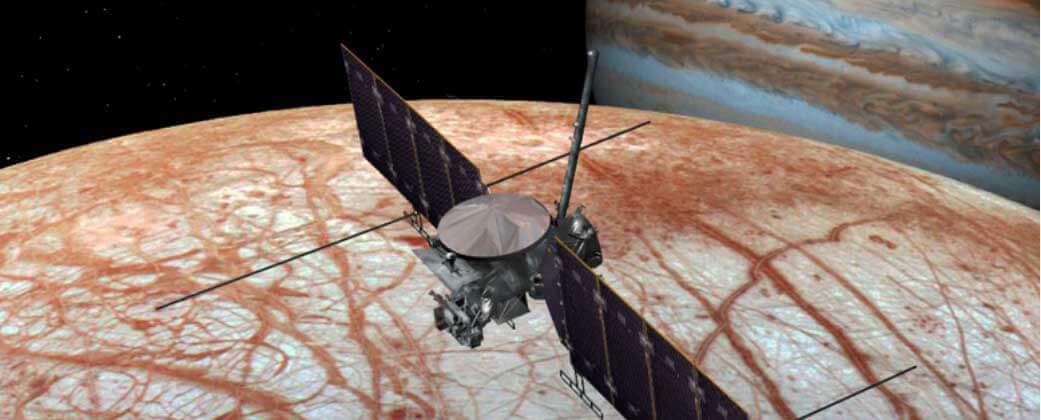Integration of Systems Models and Analytical Models Provides Order of Magnitude Time Savings

Executive Summary
- Industry: Aerospace
- Applications: MBSE: Model Based Systems Engineering
The National Aeronautics and Space Administration’s (NASA’s) Jet Propulsion Laboratory (JPL) is streamlining the space mission engineering process by integrating systems models that define the project architecture with the many analytical models used to evaluate different aspects of mission performance. The integration enables the systems models to automatically execute analytical models individually or as part of a toolchain. The project also involves the creation of intuitive web interfaces that enable practitioners without system or analytical modeling expertise to view and edit systems models and run the supporting analytical models. The integration project has demonstrated order of magnitude time savings.
Background
In the 2020s NASA’s Europa mission will conduct detailed reconnaissance of Jupiter’s moon Europa and investigate whether the icy moon could harbor conditions suitable for life. JPL’s responsibility on Europa as well as many other space missions includes developing the overall concept, designing the spacecraft, choreographing the flight plan, developing the ground system, as well as many other tasks. JPL integrates the myriad of complex and interrelated activities and the work of many technical experts involved in the Europa mission by capturing the mission architecture in SysML systems models that contain information about physical components, requirements, system architecture and mission planning. The experts in turn heavily rely upon many different types of analytical models to evaluate alternative design concepts and validate their chosen approach under a wide range of potential scenarios.
Challenge
The systems models are primarily created and maintained by system modeling specialists while the analytical models are created and maintained by analysts. On the other hand, the main stakeholders in these models are the practitioners or domain experts in various disciplines such as instrument systems engineers, flight systems engineers, mission planners, project systems engineers and ground systems engineers. The vast majority of these practitioners do not have either systems or analytical modeling expertise so they are reliant upon systems modelers and analysts. “Practitioners experience frequent delays in waiting for systems modelers to provide requested views of and edits to the model,” said Bjorn Cole, Project Systems Engineering Analysis Lead for JPL. “Practitioners face additional delays in waiting for analysts to run analytical models under specific conditions in order to evaluate the performance of new design concepts or mission scenarios.” These challenges were addressed to a limited degree in previous missions with tool-to-tool integrations that involved passing files and running parsing and update scripts. But only a limited level of integration could be achieved and the user interface left much to be desired.

"Multiple models have been wrapped and demonstrated order of magnitude time savings to the Europa team and executions supporting full project work will come next."
Solution
Phoenix Integration provided its Model Center Cloud (MCC) repository which provides a wrapper with a common web interface for any analytical simulation tool and can be used to store simulation model files and simulation run results and create and automate multidisciplinary simulation workflows. Phoenix ported its MBSEPak, which integrates systems models to MCC at the desktop level, to the server level to connect MMS with MCC. This integration allows a model stored on the OpenMBEE web-based modeling platform to automatically generate an executable workflow on the MCC web-based analysis platform.
The repositories all borrow configuration control concepts from software source control concepts to provide a new level of configuration control and data accountability. Each of them stores revisions or versions and organizes them into a common thread of development where changes are related and have a common goal.
Figure 2 shows how these multiple systems work together to generate an executable workflow from a system model in the MMS. The process starts with the development of the system model in SysML by the systems engineering team. This model is then published to MMS using the plugin for MagicDraw. In parallel, domain experts create simulation models for any analysis that is needed to compute values in the SysML model. These models are then automated, packaged for execution in MCC, and published to the MCC model store. Stakeholders can then log into MMS, browse the system architecture, propose changes in property values, generate and execute simulations based on the architecture model, and then review the results. Alternatively, stakeholders can log into MCC, browse for existing simulation workflows, and execute them directly from the MCC web interface to perform trade studies over system parameters.
Benefit
These integrations described here have been incrementally implemented. “The MPS was the first integration to be established,” Cole said. “Adding automated upload and download scripts removed multiple manual steps that previously existed with email or file server based data transfer. Incorporating the MMS has provided the ability to capture inputs on a Wiki-like web page and generate automated reports that are also visible on the web. The MCC’s ability to store the analysis method as well as the data makes it the most feature-rich component but also the most complicated to integrate so it has not yet been fully implemented. Multiple models have been wrapped and demonstrated order of magnitude time savings to the Europa team and executions supporting full project work will come next.”